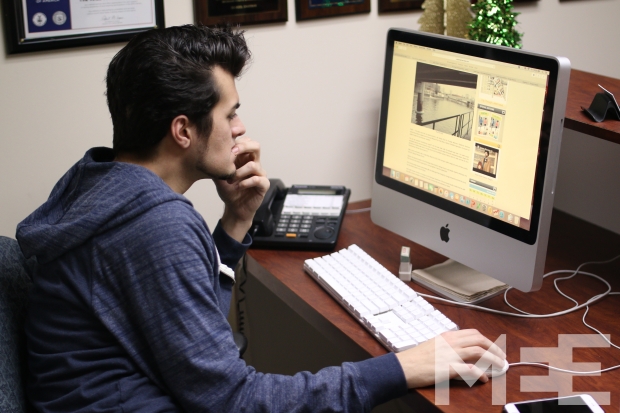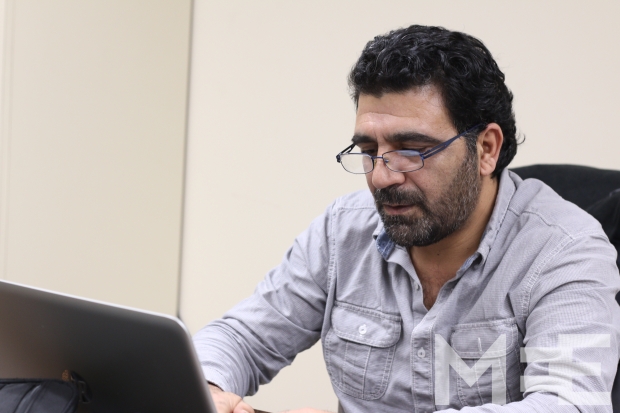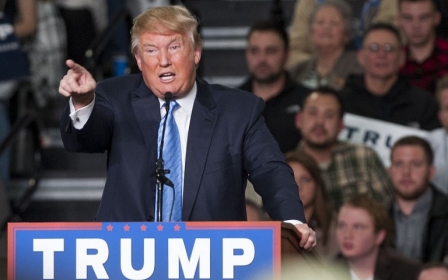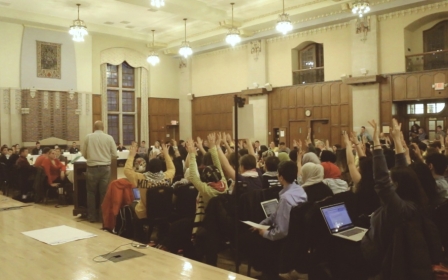Arab-American newspaper combats Islamophobia, community divisions
DEARBORN, United States - It’s past midnight at the offices of The Arab American News, the nation’s most popular and longest running Arabic-English newspaper, and the staff is rushing to finish this week’s edition before the print deadline.
“It’s that time that we come together and (decide) what goes where, what takes precedent, and what should go on the front cover,” 25-year-old Lebanese-American reporter Ali Harb told Middle East Eye.
“Typically it’s a lot of screaming, it’s a lot of clashing between the different components of the office.”
Founded to serve southeast Michigan’s Arab-American community - the largest concentration of Arabs in the US - the News has printed weekly bilingual newspapers for over 30 years.
Tonight, reporters are still putting the finishing touches on this week’s stories, many of them focused on the water crisis in nearby Flint. Graphic designers are hard at work superimposing a picture of Michigan Governor Rick Snyder onto an image of the Flint River taken by one of the journalists earlier that same day.
“Put him right in the middle of the river,” Arab American News founder Osama Siblani told the young designers.
Soon, the reporters, editors and designers gather around a computer to look at the layout of this week’s paper. Raising their voices and code-switching between Arabic and English, they debate the wording of headlines and the placement of each story.
Thursday is an all-day work day for the Arab-American journalists, most of them in their 20s, who often head out to the field for the first half of the day before returning to the office in Dearborn, where they remain until the wee hours of Friday morning.
“Typically I would say (we leave by) 2:30am, but there have been days when we’ve walked out of here at 6-6:30,” Harb said. “We’ve become immune to the stress.”
English-language writer Samer Hijazi says he does his best to focus on positive stories about Arabs and Muslims. This week, his piece on the Flint crisis centres around a group of Muslim-American activists who delivered bottled water and water filters to the city for distribution to residents on Martin Luther King, Jr. Day.
“In the mainstream media, the only time that you hear about our community is when it’s negative - you know, terrorists or Islamophobia,” Hijazi told Middle East Eye. “I think that our community is very misrepresented.”
“Our job should be to give the reflection that Arab Americans are just like any other community,” Hijazi said.
‘Hysteria against Arabs and Muslims’
Indeed, since it was founded in 1984, the newspaper’s central mission has been to dispel stereotypes about Arab Americans.
“Some of the main issues that we are facing today we were facing before, which is the distorted images of Hollywood, you know, of Arabs,” said Siblani, who serves as the publisher of The Arab American News.
Over the past several months, however, negative public sentiment about Arab Americans has come to a boiling point, with Republican presidential candidates touting “radical Islamic terror” as the top threat to the US’s national security. Some candidates have called for a moratorium on admitting Syrian refugees into the country amid the worst refugee crisis since World War II. And following the San Bernardino shooting in December, frontrunner Donald Trump called for an across-the-board ban on all Muslims entering the US.
“Since September 11, 2001, we’ve seen an escalation of violence against Arabs and discrimination against Arabs. So now it’s culminated, I think, at a level where Donald Trump is reflecting this kind of hysteria against Arabs and Muslims,” Siblani told MEE.
“It makes our mission more important, and we have to redouble our efforts. … Every day we go out and we try to make a difference and try to convince Americans and convince the world that we are a community that is worth respecting and including in the mix of this great nation,” he added.
While 65 percent of the News’ readers are Arab, according to Siblani, 35 percent are not – thus the paper seeks not only to serve the Arab-American community, but to represent the community to outsiders whose impression might otherwise be skewed by the mainstream media.
In addition to heading up the newspaper, Siblani is also seen as a community leader, and is regularly called upon to contribute an Arab-American perspective on Fox, CNN, MSNBC, among other media outlets.
“We cannot let Donald Trump or anybody from his clan identify us and define us,” Siblani said. “We have to define us.”
'Divisions'
While a focus on positive portrayals of Arabs and Muslims is a central, unifying goal of the News, other more sensitive stories that make it into the paper on a regular basis inevitably make certain elements of the widely diverse Arab-American community feel uncomfortable at times.
“The so-called Arab Spring … was bloody, continues to be bloodier and could get bloodiest. The situation in the Middle East right now is a great concern to us, and it reflects on our community, quite frankly,” Siblani told MEE.
“I mean, the community we see today is not the same community that we had when The Arab American News was established back in 1984. I think demographically, the kind of divisions we see today among our community … did not exist at that time.”
Dearborn’s largest groups of Arab Americans are Lebanese, Iraqis and Yemenis. Religiously, they are Catholic, Orthodox, Sunni, and Shia. While divisions among this vast array of nationalities and religions are far less pronounced than the racial divisions in the Detroit area, the recent turmoil in the Middle East has driven a new wedge between Arab-American identities.
“Metro Detroit is one of the most racially segregated places in the entire nation,” Harb told MEE.
“I think in the Arab-American community, we’ve learned from that model in that sub-communities have segregated themselves. … Integration is an on-going process, and it’s getting better. But I’m not going to lie and tell you that people are all intermingled; it’s not the case.”
Syrian-American Tariq Abdul Wahid, an Arabic-language reporter for the News, told MEE that some Sunnis have stopped reading the paper since the 2011 Arab uprisings.
“Just in the last five years, especially when the Syrian crisis started, some people took a stand against The Arab American News, because – they are right – they think the publisher of the newspaper is taking the side of the al-Assad regime – which is almost true,” Abdul Wahid said.
“And because those who support (Syrian President Bashar al-Assad) most likely are Shia, right now it’s sort of a division between the Sunni community and the Shia community. … The Syrian crisis has made this gap deeper.”
Additionally, growing Islamophobia in the US that has followed the rise of the Islamic State (IS) has seeped into the Chaldean, or Iraqi Catholic community, a number of News journalists told MEE. Recently, Chaldeans in the nearby suburb of Sterling Heights gathered for mass protests against a proposed mosque in the area, leading to further tensions between Middle-Eastern Muslims and Christians.
“It’s very painful when you see and meet your people, or who you consider your people … try to attack you,” Abdul Wahid said.
“As a reporter, you have to be neutral. … It’s a very critical job, especially nowadays. Because you have to keep your audience on the right track, not to push them to be biased or to be angry.”
Despite the weekly challenges in bridging the gaps between the various Arab-American identities in the area, Abdul Wahid is still confident in the News’ wide appeal to the community.
“At the end of the day, all Arabs read the paper because it is technically the best. There is no other publication that can deliver the news that people are interested in.”
A little past 2:30am, the reporters send this week’s paper to print and finally head home. On Friday, 35,000 copies are distributed for free throughout southeast Michigan.
Middle East Eye propose une couverture et une analyse indépendantes et incomparables du Moyen-Orient, de l’Afrique du Nord et d’autres régions du monde. Pour en savoir plus sur la reprise de ce contenu et les frais qui s’appliquent, veuillez remplir ce formulaire [en anglais]. Pour en savoir plus sur MEE, cliquez ici [en anglais].








